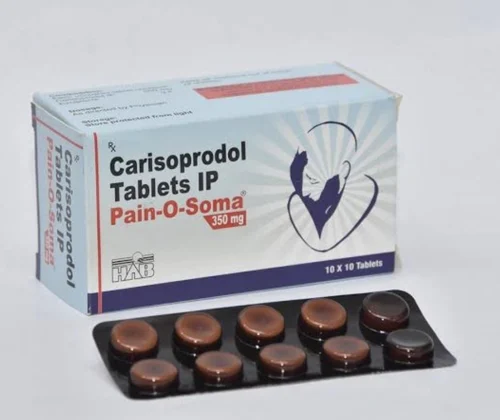Pain-O-SOMA

What is SOMA?
SOMA is the brand name for Carisoprodol, a prescription skeletal muscle relaxant. It is primarily prescribed for the relief of acute, painful musculoskeletal conditions such as back pain, sprains, or injuries.
Carisoprodol works by blocking pain signals between the nerves and the brain, which helps relax the muscles and reduce discomfort.
Uses of SOMA
Doctors typically prescribe SOMA for:
-
Short-term treatment of acute muscle pain and spasms
-
Injuries related to muscles, ligaments, or bones
-
Conditions where muscle stiffness interferes with daily activity
👉 Important: SOMA is intended to be used alongside rest, physical therapy, and other supportive treatments, not as a stand-alone cure.
Dosage Information
-
Available Strengths (Tags): 250 mg, 350 mg, and 500 mg tablets
-
Typical Adult Dose:
-
250–350 mg taken three times daily and at bedtime
-
-
Duration of Treatment:
-
Should not exceed 2–3 weeks, as its long-term effectiveness has not been studied
-
⚠️ Prolonged use increases the risk of dependence and withdrawal symptoms.
How Does SOMA Work?
Carisoprodol is a central nervous system (CNS) depressant.
-
It modifies communication between nerves and the brain, resulting in muscle relaxation and pain relief.
-
After ingestion, the body also metabolizes Carisoprodol into meprobamate, a compound with sedative and anti-anxiety effects.
Side Effects of SOMA
Common Side Effects
-
Drowsiness
-
Dizziness
-
Headache
-
Trouble concentrating
Less Common but Possible
-
Nausea, upset stomach
-
Nervousness or irritability
-
Blurred vision
Serious Side Effects (Seek Medical Help Immediately)
-
Seizures
-
Allergic reactions (rash, swelling, breathing difficulty)
-
Extreme weakness or loss of coordination
-
Signs of dependence or withdrawal (anxiety, tremors, hallucinations when stopping suddenly)
Warnings & Precautions
-
Addiction Risk: SOMA can be habit-forming. Misuse can lead to overdose or death.
-
Avoid Alcohol: Combining alcohol or other CNS depressants with SOMA increases drowsiness and overdose risk.
-
Medical Conditions: Not recommended if you have porphyria, severe liver/kidney disease, or a history of seizures.
-
Age Restrictions: Not approved for patients under 16 years of age.
-
Pregnancy & Breastfeeding: Safety not established; should only be used if prescribed.
Drug Interactions
SOMA may interact with:
-
Alcohol
-
Opioid pain medicines (e.g., tramadol, oxycodone)
-
Benzodiazepines (e.g., diazepam, alprazolam)
-
Other CNS depressants or sleep medications
These combinations can increase risk of sedation, respiratory depression, and overdose.
Manufacturer Information
-
Originally marketed in the U.S. by Wallace Laboratories (later acquired by Meda Pharmaceuticals).
-
Today, SOMA and Carisoprodol generics are manufactured by multiple pharmaceutical companies worldwide, including Sun Pharma, HAB Pharma, and others depending on region.
Frequently Asked Questions (FAQs)
Q1. Is SOMA addictive?
Yes. Prolonged or misuse of SOMA can cause dependence. It should only be taken for short periods under a doctor’s guidance.
Q2. How fast does SOMA work?
Relief usually begins within 30 minutes and lasts about 4–6 hours.
Q3. Can I drive or work while taking SOMA?
No. SOMA can cause drowsiness, dizziness, and impaired coordination. Avoid driving or operating heavy machinery.
Q4. Can SOMA be taken with ibuprofen or acetaminophen?
Yes, doctors may prescribe SOMA alongside over-the-counter painkillers. But it must always be under medical supervision.
Key Takeaway
SOMA (Carisoprodol) is an effective short-term muscle relaxant for acute musculoskeletal pain. While it provides quick relief, its habit-forming nature and risk of side effects mean it should only be used exactly as prescribed.